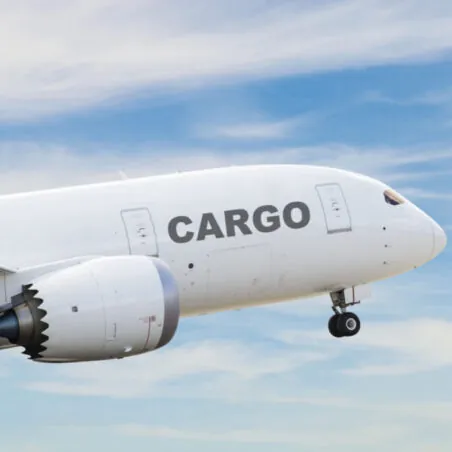9 Advantages of Air Freight
Air freight offers efficient transportation for goods via aircraft. It’s a crucial component in global logistics, offering efficient transportation of goods to anywhere in the world. Air freight makes up 35% of all global trade by value and is expected to grow in the future. Air freight is becoming increasingly popular as it holds many advantages over land and sea freight.
There are multiple planes used for transport. Dedicated freighters are used solely for cargo transport, and combi aircrafts accommodate both cargo and passengers. Charter planes are customized for specific needs and expedited services.
From speed to higher security, there are many features of shipping by air that make it a great option when transferring goods. Here are the top 9 advantages of air freight:

1. Speed
Air freight has an advantage over land and sea freight. An airplane can travel between 550-600 mph, allowing shipments to get across the country or globe in a short amount of time. It only takes 1-5 days for a package to get to its destination.
This mode of transportation is ideal for perishable items, pharmaceuticals, or products needed for specific events. This is beneficial for shippers who may need to get their shipments to its destination on a strict deadline.
2. Reliability
Air freight is reliable for multiple reasons. It is the safest form of transportation compared to land transportation, which has more accidents and traffic, leading to damaged freight and delays. Accidents are highly less likely via aircraft.
Additionally, cargo must be put through security measures, which ensure safety of the package. The reliability of air freight can relieve any stress about shipping that someone may have.
3. Flexibility
Reliability also ties in with flexibility. Regular departures are always available, so the shipper has the flexibility to decide exactly when to ship their items and what route to take. This optimizes delivery efficiency and can minimize transit times. Shippers can also choose between different shipping options such as expedited charters or express shipping.
4. Location Availability
Airplanes can virtually go anywhere. They can reach remote, challenging, and very far places that a cargo ship or truck cannot get to – and in ample time. Not only do they reach challenging places, but almost all airports serve as global key hubs, with easy access to major markets and the ability to distribute goods efficiently.

5. Security And Safety
Any air travel requires regulatory standards. Terminals and cargo receiving areas are highly monitored with many protocols in place. Packages go through screening technologies to ensure safety. In the U.S., these security measures are regulated by the TSA.
6. Quick Recovery Time
Air freight has a quick recovery time. For example, if departures are missed, it would only take as little as a few hours for the cargo to be on its route, as departures go out multiple times a day. This aids in efficiently handling cargo and maintaining delivery schedules.
7. Reduced Packaging
Air freight requires less packaging than other shipping methods to reduce the weight of the aircraft. With shorter transit times, packages don’t require as much extensive protection as they would in other modes of transportation.
In addition, most aircrafts have a climate-controlled cabin, so it minimizes the exposure of outside elements on cargo. Reduced packaging enhances handling efficiency, decreases environmental impact, and contributes to cost savings.
8. Cost Savings
Reduced packaging decreases shipping costs. Not only are shipping costs lower, but insurance premiums are lower, too. This is because air transport is a more secure method of transport, and the transit times are much shorter. Due to the rapid delivery that air freight offers, the inventory holding costs are lowered as well.
9. Tracking
Airlines offer advanced tracking that provides real-time updates, ensuring shippers can monitor their cargo’s location status throughout transit. Tracking not only ensures transparency and customer satisfaction, but helps to optimize the supply chain.


